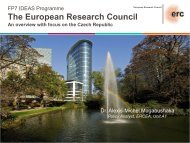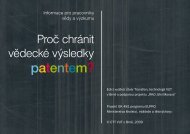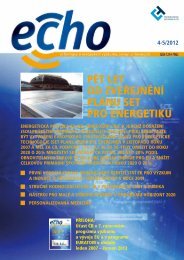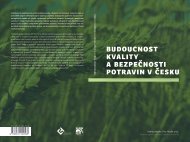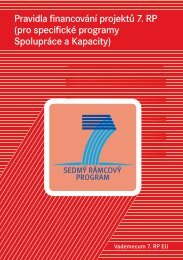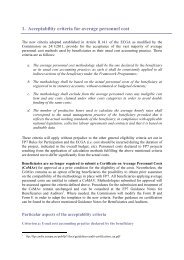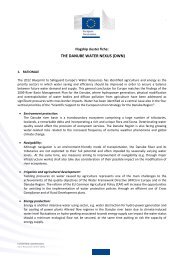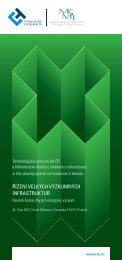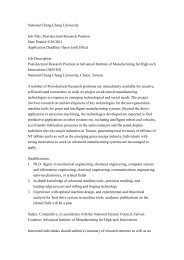Guide to Research and Innovation Strategies for Smart Specialisation
Guide to Research and Innovation Strategies for Smart Specialisation
Guide to Research and Innovation Strategies for Smart Specialisation
Create successful ePaper yourself
Turn your PDF publications into a flip-book with our unique Google optimized e-Paper software.
'thing' that a minority of people possesses, leadership is now unders<strong>to</strong>od as a dynamic<br />
relationship between leaders <strong>and</strong> led in which both sides play an active role in finding joint<br />
solutions <strong>to</strong> common problems. In this context, a way <strong>to</strong> secure underst<strong>and</strong>ing <strong>and</strong> ownership of<br />
the main strategic orientations is <strong>to</strong> allow <strong>for</strong> effective collaborative leadership among the key<br />
ac<strong>to</strong>rs involved in the process. When innovation processes embrace many different areas of the<br />
society, as in the case of RIS3, collaboration among stakeholders holds the key <strong>to</strong> successful<br />
implementation of innovative practices, implying that leadership has <strong>to</strong> be shared <strong>and</strong> exercised<br />
across organisations. Collaborative leadership requires the emergence of collaborative practices;<br />
as ac<strong>to</strong>rs must find ways of managing conflict themselves.<br />
In order <strong>to</strong> moderate the RIS3 design process, ac<strong>to</strong>rs playing the role of boundary spanners<br />
between the organisations are needed. These are ac<strong>to</strong>rs endowed with an interdisciplinary<br />
knowledge or experience of interaction with several different types of organisations; they hence<br />
can facilitate new connections across sec<strong>to</strong>rs, foster new conversations between disciplines, <strong>and</strong><br />
inject novelty in<strong>to</strong> the process, <strong>and</strong> this in turn helps <strong>to</strong> overcome the sec<strong>to</strong>ral <strong>and</strong> disciplinary<br />
silos that reproduce old habits <strong>and</strong> routines, locking regional economies in<strong>to</strong> their traditional<br />
paths of development.<br />
Boundary spanning skills tend <strong>to</strong> emerge from activities that straddle sec<strong>to</strong>rs, disciplines <strong>and</strong><br />
professions <strong>and</strong> they are invariably fashioned in action learning environments where there is a<br />
high degree of novelty associated with the activity. Examples of such activities include<br />
technology transfer, knowledge exchange, venture funding, regional economic development,<br />
business services, <strong>and</strong> management consultancy, all of which af<strong>for</strong>d an overview of the regional<br />
economy. Formal recognition of the boundary spanning role, <strong>and</strong> its significance <strong>for</strong> universities,<br />
businesses <strong>and</strong> the regional economy, would do much <strong>to</strong> promote a skill set that is critically<br />
important <strong>to</strong> the moderation of the RIS3 process, particularly of the entrepreneurial process of<br />
discovery, which lies at the heart of the process.<br />
As far as the structure of the management body is concerned, it will clearly vary according <strong>to</strong><br />
local circumstances, it must be supported by robust governance arrangements. The RIS<br />
experience is instructive here because it shows that local diversity can exist within a generic<br />
governance system. The governance system of a typical RIS project revolved around three<br />
elements – Steering Group, Management Team <strong>and</strong> Working Groups – <strong>and</strong> they worked in the<br />
following way:<br />
• Steering Group: the SG was responsible <strong>for</strong> the overall per<strong>for</strong>mance of the project <strong>and</strong> it<br />
normally included members of the business community, local <strong>and</strong> regional government,<br />
<strong>and</strong> key innovation ac<strong>to</strong>rs, all of whom were expected <strong>to</strong> embed the project in their<br />
respective fields of activity. The size of the SG was always carefully considered: <strong>to</strong>o few<br />
members could compromise the consensus-building process, while <strong>to</strong>o many members<br />
could be a recipe <strong>for</strong> a bureaucratic <strong>and</strong> unwieldy process. An appropriate balance was a<br />
membership of around fifteen people meeting as a group every two or three months. The<br />
main tasks would typically include the following: setting objectives <strong>and</strong> moni<strong>to</strong>ring<br />
activities; selecting the members of the Management Team; supervising the work<br />
programme; political <strong>and</strong> institutional support; <strong>and</strong> liaising with the European Commission.<br />
39



